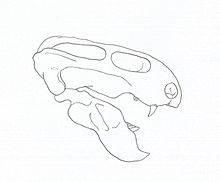Emydopidae
|
Emydops Temporal range: Middle - Late Permian |
|
|---|---|
 |
|
| Skull | |
| Scientific classification | |
| Kingdom: | Animalia |
| Phylum: | Chordata |
| Clade: | Synapsida |
| Order: | Therapsida |
| Infraorder: | †Dicynodontia |
| Family: |
†Emydopidae Cluver and King, 1983 |
| Genus: |
†Emydops Broom, 1912 |
| Species | |
|
|
Emydops is an extinct genus of dicynodont therapsid from the Permian of South Africa. Emydops was first named by South African paleontologist Robert Broom in 1912 when he described Emydops minor. In the following years, the genus grew to include thirteen species. Many of these species were erected on the basis of differences in the teeth and the positioning of the frontal and parietal bones. A 2008 study narrowed Emydops down to two species, E. arctatus (first described by English paleontologist Richard Owen as Kistecephalus arctatus in 1876) and the newly described E. oweni.
Both species of Emydops are small. The skull of Emydops was 5 cm (2 in) long. Tusks are present in most skulls, but some lack them. The eye sockets are positioned far forward in the skull and face somewhat forward and upward. A wide area on the lower jaw called the lateral dentary shelf is another distinguishing feature of the genus. The temporal regions behind the eyes are large, and the back of the skull is wide and square-shaped. The holotype specimen of E. oweni is unusual in that it has two pairs of tusks. The second pair of tusks is not seen in any other dicynodont, and is a feature unique to the specimen. The extra tusks are considered a pathological feature; they are thought to have been the result of a mutation in the individual and are not considered a defining characteristic of the species.
...
Wikipedia
